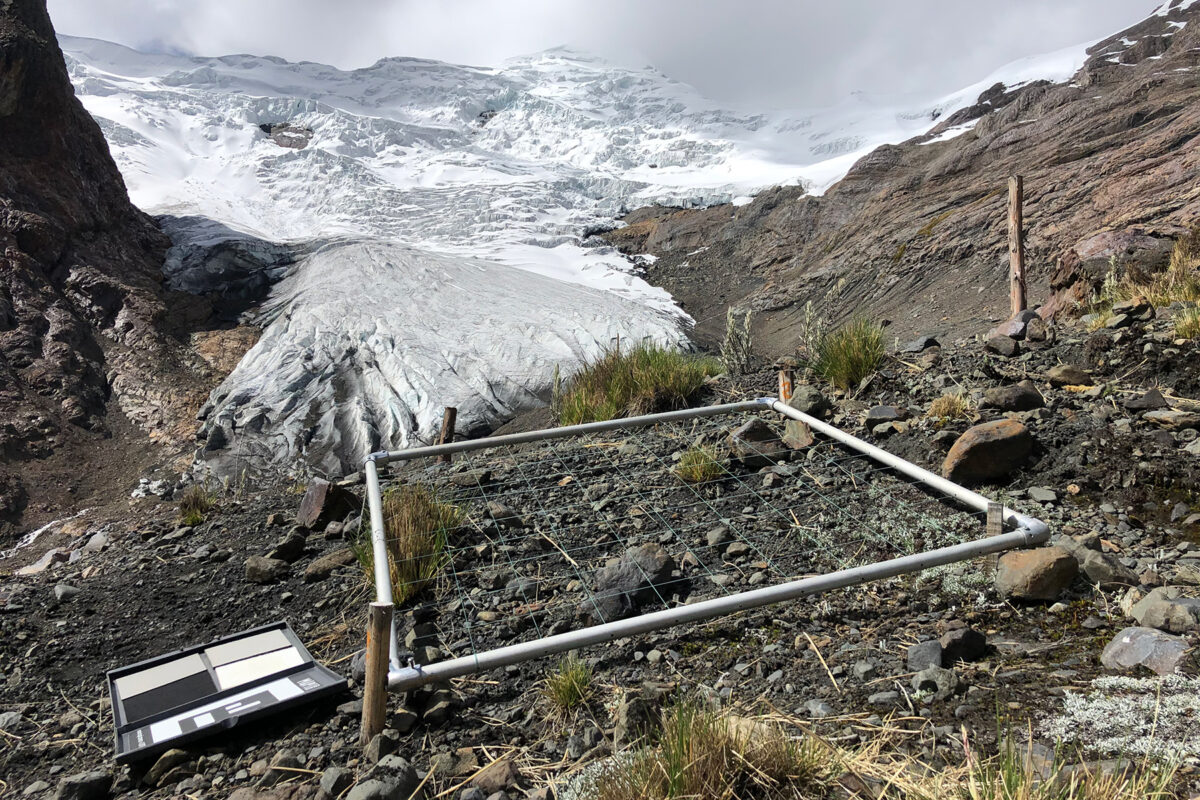Llamas, bred from the wild vicuña, are culturally important in Peru. They provide labor, wool, food, fuel, and fertilizer to the mountain residents who have herded them for 6,000 years. The animals are light enough that they can tamp seeds into the soil without trampling them. They disperse seeds with their fur and hooves—and even their dung, the research team showed.
The soil enhancements brought by the llamas are vital to help prevent one of the largest direct impacts of glacial retreat: acid rock drainage. Acids, heavy metals and other contaminants previously locked away under the glacier get washed down into water bodies, food supplies, and farms. The Uruashraju glacier on the study site lost about half of its length from 1948 to 1990. All of that lost water carried acid downstream into farms and villages.
 An area sectioned off for plant monitoring throughout the study. Photo credit: AnaĂŻs Zimmer
An area sectioned off for plant monitoring throughout the study. Photo credit: AnaĂŻs Zimmer
To understand how llamas might help this barren post-glacial ecosystem, Zimmer and her team sectioned off eight plots of land in the shadow of the glacier, almost 5,000 meters (16,400 feet) above sea level. In half of these plots, the researchers brought herds of three llamas to graze the land for three days each month. The other four plots were left ungrazed. The team measured the variety of plants and their health, as well as the composition of the soil, to understand how the newly exposed ecosystem changed over time.
Every time llamas visited from the more diversely vegetated lowland, they brought fertilizer in the form of their dung, rich with nitrogen and organic carbon. Once spread on the barren landscape, the dung improved soil health and helped plants grow faster. The llamas also brought seeds, which scattered among the llama plots and sprouted into far more plants than in the test plots.
“They took an experimental approach, and they essentially manipulated primary succession,” the first steps for organisms to recolonize a barren area of land, said ecologist Kelsey Reider of James Madison University in Harrisonburg, Virginia, who was not associated with the study. “I don’t know of any other instance where people have actually taken an experimental approach to doing that.”
 Plant regrowth within the plot grazed by llamas. Photo credit: AnaĂŻs Zimmer
Plant regrowth within the plot grazed by llamas. Photo credit: AnaĂŻs Zimmer
The Llama 2000 Asociación, a group of Peruvian farmers founded to restore the cultural practice of llama herding through tourism, had suffered as more glaciers melted and the COVID-19 pandemic affected the region. The association worked with Zimmer’s research team to provide the animals and the expertise needed to bring the native herbivores back to the remote landscape.
“The project helps us develop our knowledge regarding the preservation of plant resources, and it motivates us to continue learning management techniques” as the climate changes, said Jorge Martel, a mentor within the Llama 2000 Asociación, in a message to Mongabay.
Zimmer looks forward to her team’s ongoing ties with Peruvians—and their animal companions—who are coping day-to-day with the impacts of melting glaciers. “The research question was just super exciting,” she said. “It was very interesting to try to answer a local need in collaboration with the local population.”
Citation:
Zimmer, A., Beach, T., Riva Regalado, S. et al. Llamas (Llama glama) enhance proglacial ecosystem development in Cordillera Blanca, Peru. Scientific Reports 13, 15936 (2023). doi: 1038/s41598-023-41458-x
Header image: Llamas moving through the harsh post-glacial landscape below the Uruashraju glacier. Photo credit: AnaĂŻs Zimmer
Sierra Bouchér is a graduate student in the Science Communication Program at the University of California, Santa Cruz. Other Mongabay stories produced by UCSC students can be found here.
Source link : https://news.mongabay.com/2023/11/llama-herding-helps-community-in-peru-recover-from-a-melting-glacier/
Author :
Publish date : 2023-11-27 03:00:00
Copyright for syndicated content belongs to the linked Source.












